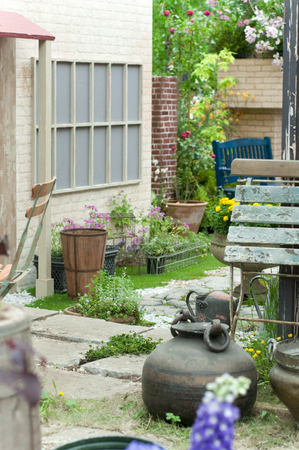Introduction: Envisioning Tranquility in the British Garden
Imagine stepping into a lush British garden just as dawn breaks, where the air is tinged with dew and the gentle hum of life stirs beneath ancient oaks and fragrant rose bushes. Here, within these cherished outdoor sanctuaries, there lies an invitation to experience harmony not only with nature but also within oneself. The timeless art of Feng Shui, rooted in the wisdom of ancient China, offers a soulful approach to shaping spaces that nourish our spirit. When blended with the quintessential charm of a British garden—think weathered stone paths, whimsical wildflowers, and secret nooks—the result is more than mere landscaping; it becomes a living retreat for the soul. This exploration sets the scene for discovering how the principles of Feng Shui can be woven seamlessly into British gardens, guiding us towards creating outdoor spaces that radiate balance, peace, and a deep sense of belonging.
Core Principles of Feng Shui: A Timeless Wisdom
At the heart of Feng Shui lies an ancient wisdom, rooted in the art of balance, energy flow, and harmonious interaction between people and their environment. When we look at British gardens—whether an urban courtyard in Manchester or a sprawling country retreat in Kent—these principles take on a unique resonance. Let us gently unpack the foundational elements of Feng Shui and explore how they naturally intertwine with British sensibilities and landscapes.
The Five Elements and British Gardens
Feng Shui draws deeply upon the five elements: Wood, Fire, Earth, Metal, and Water. Each element brings its own personality and energy to a space, echoing the ever-changing moods of the British outdoors—from misty mornings to sunlit afternoons. In British gardens, these elements often appear as:
| Element | British Garden Features |
|---|---|
| Wood | Mature oaks, climbing roses, rustic trellises |
| Fire | Terracotta pots, lanterns, vibrant perennial borders |
| Earth | Stone walls, gravel paths, herbaceous borders |
| Metal | Copper bird baths, wrought iron gates, garden tools |
| Water | Ponds, fountains, gentle rain chains |
Qi: The Flow of Life Energy
The British have long cherished meandering paths and secret nooks—a natural alignment with the Feng Shui principle of Qi (pronounced “chee”), or life energy. In traditional Chinese philosophy, Qi must flow freely and smoothly; similarly, a well-designed British garden invites gentle movement and discovery around every corner. This principle encourages us to avoid straight lines and harsh corners in favour of curved pathways and layered planting—a dance between order and wildness that feels both comforting and enlivening.
Harmony with Nature: A Shared Heritage
At its essence, Feng Shui is about living in harmony with nature’s rhythms. British gardening tradition is steeped in this very idea—the celebration of native plants, wildlife-friendly habitats, and seasonal change. Whether tending to bluebells beneath ancient trees or cultivating kitchen herbs by a cottage door, there’s an intuitive understanding that gardens are living canvases shaped by time and care.
Cultural Resonance: East Meets West
The beauty of Feng Shui in Britain is its subtle adaptability. While born from Eastern philosophy, its core values—balance, respect for nature, mindful placement—find kindred spirits in British horticultural practices. As we explore further into the art of harmonising outdoor spaces, we’ll see how these timeless principles breathe new life into familiar landscapes, creating sanctuaries where spirit and soil meet.

3. The Spirit of British Gardens: Tradition Meets Energy Flow
To truly harmonise a British outdoor space using Feng Shui, one must first honour the deep-rooted traditions that make these gardens so enchanting. Picture the gentle curves of a cottage garden, where foxgloves and hollyhocks rise amid a tangle of lavender and rosemary, their fragrance entwining with the morning mist. These meandering borders are not just a visual delight—they encourage the qi, or life energy, to weave gracefully through the landscape, nurturing every corner with vitality and balance. The stately lawns found in grand country estates evoke a sense of calm expansiveness, offering a stage for energy to circulate freely under vast skies.
British gardens have always been more than ornamental; they are stories in bloom. Each path tells tales of afternoon teas and secret rendezvous beneath ancient oaks. When we introduce Feng Shui principles into this narrative, we do not erase tradition—we amplify it. The placement of a weathered bench beneath an old apple tree creates a sanctuary for contemplation, harnessing both the wisdom of the land and the flowing currents of energy. A softly babbling water feature at the edge of a lawn invites abundance and renewal, echoing the gentle rains so cherished by gardeners across Britain.
By weaving together these distinctly British elements—cottage charm, sinuous borders, and dignified lawns—with mindful Feng Shui design, we invite harmony not only into our gardens but also into our lives. It is here, among scented blooms and dappled shade, that tradition meets energy flow, creating a living tapestry as dynamic as it is serene.
4. Five Elements in the British Context
To truly harmonise a British garden using Feng Shui, it is essential to weave the ancient wisdom of the five elements—earth, water, fire, wood, and metal—into the very heart of our outdoor sanctuaries. Each element breathes its own energy into our cherished roses, winding ivy, sturdy stone pathways, and even interacts with the famously unpredictable British weather. The interplay between these elements and our local flora creates a living tapestry that both grounds and uplifts.
Earth: The Steadfast Foundation
British gardens often feature robust stone walls or cobbled paths, grounding spaces with a sense of permanence. Earth is also found in the rich loam nourishing beds of lavender and foxgloves—a vital anchor for growth and stability. The use of terracotta pots or gravel beds under drizzly skies accentuates this element’s presence, lending gardens a calm solidity.
Water: Reflective Serenity
The gentle trickle of a birdbath or the mirrored surface of a small pond brings water’s flow to life amidst English topiary. Rainfall, ever-present in Britain, is harnessed through clever drainage or rain chains, ensuring movement and clarity while avoiding stagnation. This element softens hard edges and invites both wildlife and contemplation.
Fire: A Touch of Warmth
Though British gardens are more often cool than sultry, fire finds its place in lanterns hanging from pergolas or the blaze of late summer dahlias. Evenings come alive with fire pits or candles glimmering beneath rose arches—a subtle yet powerful invitation for friends to gather despite the chill. Fire brings passion and sociability to outdoor spaces.
Wood: Lush Life Force
From centuries-old oaks to climbing ivy along brick facades, wood manifests as both structure and vitality. Well-tended hedgerows, timber benches set among snowdrops, and willow fences all echo the deep-rooted resilience of wood in British landscapes. Wood encourages upward movement and renewal—mirroring spring’s unstoppable surge.
Metal: Subtle Strength
The gleam of wrought-iron gates or copper planters introduces metal’s crisp clarity. Garden ornaments—perhaps a sundial or vintage watering can—reflect not only sunlight but also intention. Metal sharpens focus within lush abundance, bringing balance especially when grey clouds gather above.
| Element | British Garden Feature | Sensory Impact |
|---|---|---|
| Earth | Stone pathways, terracotta pots | Groundedness & stability |
| Water | Ponds, rainfall features | Calm & fluidity |
| Fire | Candles, fire pits, vibrant blooms | Warmth & sociability |
| Wood | Trees, hedges, timber benches | Growth & vitality |
| Metal | Iron gates, metallic ornaments | Clarity & refinement |
The essence of British garden Feng Shui lies in attuning these five elements to local context—the scent after rain on old stones, the shimmer of light through beech leaves after a storm. When each element is honoured among roses and ivy under shifting skies, harmony naturally blossoms within every corner of your outdoor retreat.
5. Practical Harmonisation: Turning Theory into Garden Reality
Imagine stepping into a typical British garden at dawn, the air crisp and the dew shimmering on the lawn. Here, the true magic of Feng Shui unfolds—not just in theory, but through every tangible choice you make. Let us walk together through this morning mist, transforming your outdoor space with energy-balancing steps inspired by both ancient wisdom and local traditions.
Begin with Hedges: The Living Boundaries
Picture yourself tracing the edges of your garden with your fingertips. In Britain, yew and box hedges are more than classic—they’re guardians of harmony, softening harsh boundaries while protecting the gentle flow of chi. When you plant or trim these living fences, do so with intention: curve them gently to guide energy, avoiding sharp corners that might disrupt natural currents. This subtle shaping weaves a tapestry of tranquillity around your home.
Seating: Inviting Stillness and Connection
Now, pause beneath an ancient oak or beside a fragrant lavender bed. The placement of seating is pivotal; it invites conversation or quiet contemplation. Imagine a weathered wooden bench facing south-east, basking in gentle morning light—a traditional British orientation that welcomes warmth and opportunity. As you choose your spot, sense where you feel most at ease, protected by hedges yet open to uplifting views. This is where balance settles in your bones.
Ornaments: Storytelling through Stone and Sculpture
Consider the ornaments that dot your garden—perhaps a moss-covered sundial or a whimsical stone hare hidden among bluebells. Each object tells a story and anchors energy. In Feng Shui, avoid clutter and seek meaningful placement: let statues gaze towards pathways to encourage movement, while birdbaths rest near shrubs to foster life-giving gatherings. Choose motifs that resonate with your spirit and local folklore for a uniquely British touch.
Native Flora: Planting with Purpose
The soul of your garden lies in its plants. Embrace native flora—foxgloves nodding in dappled shade, wild primrose brightening shaded borders, or hardy ferns unfurling by cool walls. These species harmonise effortlessly with the land’s natural rhythm. Plant in flowing drifts rather than rigid rows, mirroring the gentle undulation of British meadows, and allow each grouping to echo the five elements—earthy tones from heathers, fiery reds from poppies, water-loving irises by ponds, airy grasses swaying in the breeze, and wooden trellises supporting climbing roses.
Your Guided Ritual for Every Season
With each change of season, walk your garden mindfully at sunrise. Notice what feels stagnant or overgrown—prune with gratitude, rearrange ornaments as needed, and replenish plantings using local guidance from your village nursery. Over time, these small rituals become acts of loving attunement, turning theory into a living reality where energy flows joyfully and every corner whispers peace.
6. Mindful Maintenance: Sustaining Flow Through the Seasons
As the gentle rhythm of the British seasons weaves its tapestry across your garden, mindful maintenance becomes the heartbeat that sustains harmony and chi. Both Feng Shui philosophy and the time-honoured traditions of British gardening share a reverence for ongoing care—a quiet, attentive partnership with nature that extends far beyond mere aesthetics.
Embracing the cycles of growth and rest, gardeners here understand that each season brings its own rituals. In spring, as daffodils nod awake and cherry blossoms blush, clearing away winter’s remnants allows fresh energy to circulate. Pruning, mulching, and aerating soil are not just chores; they are acts of intention, inviting renewal and balance.
Summer’s abundance calls for nurturing—watering at dawn to conserve dew-kissed moisture, deadheading roses to encourage continual bloom, and mindfully shaping hedges so light can dance through every corner. This is the art of sustaining flow: tending with presence so that both beauty and wellbeing flourish together.
When autumn leaves begin their golden descent, British gardeners gather them not as waste but as future nourishment, creating compost heaps or mulch that will protect roots from winter’s chill. Feng Shui teaches us to release what no longer serves; here, letting go becomes a gentle ritual—clearing ponds, tidying borders, and stowing tools with gratitude for their service.
In winter’s hush, reflection reigns. Paths are swept free of frost, bird feeders replenished for feathered visitors, and evergreens tended as living symbols of resilience. It is a time to walk the garden slowly, noticing where qi may stagnate and how subtle adjustments—perhaps moving a bench or lantern—can restore gentle flow even in stillness.
By honouring these seasonal rhythms with mindful attention, you cultivate a space where British charm and Feng Shui wisdom entwine. Each small act of care—rooted in tradition yet alive in the present—ensures your garden remains an oasis of balance and beauty all year round.


